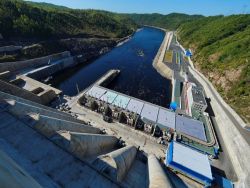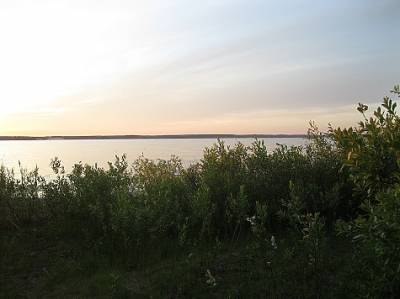
16 August, the government of the Russian Federation included in the Federal target program “Development of transport system of Russia” Bagaevskiy the construction of the dam on the don. The project, which is planned to spend 22 billion rubles, calculated until 2020. According to the authors, the largest river of the South of Russia, which is Russian tradition referred to as “the don-Father”, will be a powerful transport artery capable of meeting the needs of carriers increased dramatically after the annexation of Crimea.
However, opponents of the construction, including leading scientists and environmentalists rightly point out that the construction of new dams, in fact, will destroy the already heavily “passed” in recent years, the river, and the only prevailing party in the end will be the officials who took to “cut” a solid chunk of the Federal budget.
Like the best
The first proposal to build a dam in the village Arpachin Bagayevskaya district of Rostov region was made in 1950-ies, then the issue was discussed in the 1980-ies, but to implement a particular project, however, never came. The main purpose of dam construction on the lower don was the increase in transit depth (the smallest depth on the inland portion) up to 4 meters. In addition to the construction of hydro – Tsimlyansk (1952), Nicholas (1974) and Constantine (1982) – were large-scale dredging.
At first it seemed that the development of navigation on the don, the construction of dams and reservoirs will not damage the ecology of the river. On the contrary, after the launch of the Tsimlyansk reservoir, when it was flooded vast areas and fish has received a new, vast area, spawning ground, an explosion was recorded fishery. But 70-80-th years of the last century the situation began to change with catastrophic speed. In addition to the direct pollution of rivers by industrial and agricultural effluents, the main enemies of the don of wildlife, and the river itself was generally constructed by human waterworks, which are unable to cope with its main task – to ensure the smooth navigation of the don.
First, it affected the entire migratory fish that went to the don to spawn from the sea of Azov, and it is the most valuable species – sturgeon and Beluga. Efficiency risoprodol and rybopromyshlennikov, which was equipped with the don of the dam, was extremely low – only 3% fish to complete the spawning. In the end, if in 1940, the catch of sturgeons was more than 5 thousand tons per year, and in the 1980s 1.5 thousand today – zero. In the early 21st century of the 44 species of valuable fish species of the Azov-don fish for industrial fishing there were only two or anchovy and sprat.
The second problem was the decline of the water level in tsimlyanskoye reservoir, the dam of which is doctor of technical Sciences, head of the public organization “Green don”, member of the Supreme ecological Council under the state Duma Vladimir Lagutov considers most pointless in the world. The last flood on the reservoir was 25 years ago (in 1991) and since then the water level in it continued to fall, reaching in November of last year, the critical level of 31.22 metres. In this reservoir, and the don, and its feeder rivers, which for decades has not been cleaned, silting, which also degrades the quality of water and tempting food base of fish. However, the spillway from the Simleu still carried out only in cases, when required in the interest of navigation, but not of the local fauna. In fact, don transformed from a natural object in a man-made channel to transport goods.
However, the position of these precious discharges from the reservoir still do not save. The Taganrog Bay of the Azov sea, which flows into the don, regularly dries out, and dozens of ships are unable to enter the river. The decline in water level has meant that the regional areas of the river Delta, for example, the Dead Donets and Pork arm began to wither away. Simultaneously with the decrease of the runoff of the don into the sea, increasing the salinity of the latter (due to the receipt of water from the Black sea) and valuable fish species are displaced by weeds.
As for the quality of the don water, then it today, you can find almost the whole periodic table: calcium and magnesium, iron, ammonia, boron, manganese and its compounds, nitrates, sulfates, phosphates, chlorides, sodium, aluminium. Given the surge of water from the Azov sea, the water in the don river can hardly be called fresh. Vladimir Lagutov last year called the state of the river “suicide” and predicted that if no action is taken, the don would soon become a swamp.
The government’s response
However, there were people in power concerned. In February this year the Deputy of the state Duma Oleg Pakholkov has sent Prime Minister Dmitry Medvedev a letter with a request to instruct the Ministry of natural resources and environment on the development “road map” for the rehabilitation of two major Russian rivers – the Volga and the don. The Deputy, in particular, it was proposed to launch him at the special court who would be involved in cleaning water. It is significant that about any “road map” to rescue rivers the Russians since then have not heard, but after a couple of weeks after the appeal of the Deputy Medvedev ordered the government to include in the strategy of development of inland water transport of the Russian Federation until 2030, the project of Bagaevskiy waterworks. It is expected that the design work on this facility will begin in September – they will spend 700 million rubles. And, it seems, the noise raised by social activists and environmentalists, did not bother neither the Federal nor the local authorities or relevant agencies.
According to one of the defenders of the project, the head of the Azov-don basin administration Sergei Gagaeva, the construction of Bagaevskiy waterworks completely solves the problem of providing the required depths on the lower don and will require only minimal dredging. The official said that during the construction of the dam in the flood zone get site, and so regularly flooded floods (despite the fact that the last time don came out of the banks back in the 90s), and the emergence of a new dam “will have a positive impact on the residents, businesses, wildlife and the land” of Rostov region, providing it in the required amount of fresh water. In 2013, at a round table to discuss Bagaevskiy hydroelectric, other representative of government, Deputy head of the Federal Agency of Maritime and river transport Viktor Vovk put it more pathetically: “We are all here without exception are interested to save our fish stocks, as much as possible not to disturb the ecosystem. After all, we have families and we don’t want to leave behind a desert.”
Opponents of the dam believe that such statements from the evil one. First, they say, the project has no economic sense: even discarding the possibility that is inherent to this 22 billion is not the final figure and may increase the costs, the payback period is programmed in 50 years. By this time, the oil fleet, in whose interests built the dam, can remain without work, because in the context of depletion of hydrocarbon reserves he will simply be nothing to transport. And economic classifications do not speak in favor of the don as a route for transportation of oil. Transneft is building a pipeline from Volgograd to Novorossiysk, other active players in the region – Iran and Azerbaijan plan to build a canal and railroad from the Caspian sea to the Gulf ports.
Moreover, reminds the head of the regional branch of the movement “Eka” Grigoriy Boldyrev, to build the dam will be at the expense of the Federal budget, and the profit from the project will be river transport company, which will transfer to the Treasury of income taxes in the amount of 10-15% of their earnings. Therefore, the payback period grows to 400-500 years.
In addition, all calculations on repayment and expediency of construction of the dam (by the way, to solve the problem of providing navigation on the lower don, the opponents of the new dam offer, clearing irrigation canals and flowing into the don river and going to court with lower draught, as is done all over the world) are based on the assumption that in 2030 the don will carry 30 million tons of cargo, whereas in Soviet times the peak indicator does not hold up to 14 million tons per year, and today is just 8.7 million. Based on what the optimism of the government is not entirely clear, especially given the current stagnation of the Russian economy and its dim prospects.
In addition to the economic shortcomings of the project, indicates that after the construction of the dam will be flooded vast territory, including occupied by vineyards and other crops. Not only that, people were simply expelled from their land, the flooding will cause the rise of groundwater with a high salt content that will speed up the salinization and waterlogging of soils. Spilling water on large areas will lead to the fact that it will be more warm, which in turn will provoke a multiplication of blue-green algae that make the water unsuitable for fish habitat. As well as for drinking. Bacterial and viral pollution of water will inevitably follow, says the chief technologist of “Rostovvodokanal” Igor Touch.
And finally sturgeon. Today they spawn on the don, according to media reports citing data from the Azov research Institute of fisheries that regularly occurs in the only place in the lower reaches of the river, where it empties into a tributary of the Sal. This site is located between the current Kochetov and planned dam in the case of the buildings of the last because of low flow rates the river would be subjected to siltation, thus becoming unsuitable for spawning. For this reason, it will be possible to say goodbye to all prospects of revival of fish farming, which only began to recover after the Soviet economy and the dominance of poachers in the 90s.
In March of this year, the opponents of the construction of the dam sent a petition to President Vladimir Putin, stating that the dam “will finally destroy all valuable don fish, podtopit several settlements, and, most importantly, one of the most beautiful sections of the river protected by Islands and sandy beaches will turn into a rushy swamp to waterway”. “If the budget has extra money, please prevent them from “laundering” in the don, and directed to more pressing needs, for example, improvement of access roads to the resorts of the Crimea (occupied territory – approx. ed.) and the Caucasus”, – said the authors of the document.
As subsequent events showed, the government once again turned a deaf ear to the requests of the public – the dam to be. And now, as noted by Vladimir Lagutov, closed between Alex and Bagayevskaya dams, the lower don will die completely.








